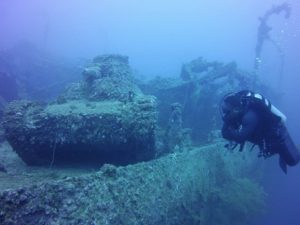Truk Lagoon: Exploring the Sunken History of WWII – Diver’s Paradise in the Pacific
Discover the Wrecks, Beauty, and Adventure in the Heart of Micronesia
In the midst of the vast Pacific Ocean lies an enigmatic world like no other, where history, marine life, and adventure converge. Truk Lagoon, often referred to as Chuuk Lagoon, is a diver’s haven that conceals a wealth of secrets beneath its tranquil surface. It’s a paradise for divers who appreciate rusted relics and have an insatiable appetite for history. Beyond the serenity of the water’s surface, Truk Lagoon opens up to a different realm, where the remnants of a bygone era lay dormant beneath the waves. These submerged shipwrecks have been transformed into stunning artificial reefs, providing shelter and sustenance for the local marine life.
Truk Lagoon’s uniqueness is defined not only by its underwater treasures but also by its accessibility. The calm, protected waters of the lagoon make it an ideal destination for divers of all levels. With water temperatures hovering around 30 degrees Celsius and minimal currents, it offers a comfortable and inviting environment. Even those without a particular penchant for wrecks will find themselves captivated by the lagoon’s wonders.
Where is Truk Lagoon, and When to Go?
Truk Lagoon is nestled in the heart of the Pacific, part of the Federated States of Micronesia. This idyllic location is situated to the north of Papua New Guinea and to the southeast of Guam. The lagoon’s inviting waters can be explored year-round, thanks to its tropical climate and consistent weather. The dry season, from November to April, and the wet season, from July to October, offer diverse experiences for divers. Throughout the year, temperatures range between 25 and 30 degrees Celsius, with a prevailing high relative humidity.
How to Reach Truk Lagoon?
Embarking on a journey to Truk Lagoon is relatively straightforward, though it may require multiple flights to reach this remote destination. Regular flights connect Weno, the Truk Airport, with key hubs like Guam, Manila, Hawaii, or Port Moresby in Papua New Guinea. United Airlines is a major carrier with frequent flights from Guam. If you’re transiting through Guam, remember to complete your ESTA application in advance, as Guam is an American territory. Additionally, a departure tax of 40 US Dollars is required before leaving the island on your return journey.
Unveiling the History of Truk Lagoon
To truly grasp the allure of Truk Lagoon for wreck enthusiasts worldwide, one must journey back to 1944. In the midst of World War II, the Pacific War raged between Japan and the United States. Truk served as a vital forward base for the Japanese fleet. In 1944, despite its diminishing significance, the Japanese anticipated an attack in this area, and numerous transport ships remained anchored in the bay. To reduce enemy forces, the Americans devised a plan to destroy the remaining ships in the atoll. This little-known historical event, known as Operation “Hailstone,” took place on February 17-18, 1944, involving around 40 ships and 300 planes based in the atoll. Most of these vessels met their demise during the bombing raids.
Today, the lagoon hosts approximately thirty planes scattered across its waters, resting at various depths and requiring technical certifications to explore. These wrecks offer a glimpse into the past, allowing divers to witness how crews lived 75 years ago. Everyday items, from dishes to telegraphs and even officers’ quarters, paint a vivid picture of a bygone era. Many of the ships were used for transport and were undergoing repairs at the time of the attack, leaving their holds empty. As a result, some wrecks still house weapons, ammunition, and even torpedoes.
Operation Hailstone
Diving in Truk
Exploring Truk Lagoon can be done in two ways: by liveaboard or as a land-based resort with day trips. Opting for a liveaboard experience is highly recommended, as it minimizes travel time to reach the dive sites, which can be quite scattered. The SS Thorfinn is a top choice, offering everything you need for an exceptional dive adventure.
Each dive site boasts a mooring buoy at 5 meters, simplifying the descent and site location. The wrecks are often visible from the surface, making the experience accessible to all types of divers, whether recreational or technical. Depths range from just below the surface to 70 meters and beyond, offering a diverse range of experiences.
It’s important to note that taking items from the wrecks is strictly prohibited, which has helped preserve these historical sites. As a result, the wrecks remain in remarkable condition, allowing divers to admire numerous artifacts.
Marine life thrives in Truk Lagoon. The wrecks serve as havens for countless reef fish, and encounters with turtles and patrolling sharks are not uncommon. The natural reefs in the vicinity are also in pristine condition, creating a welcoming environment for diverse species.
The most famous wreck in the lagoon is the San Francisco Maru, known as the “million-dollar wreck.” This deep, rich site rests on a seabed at 63 meters and is home to an abundance of artifacts, as well as tanks and cannons visible on the bridge at a depth of 50 meters.
For Wreck Enthusiasts, the Adventure Awaits
For those passionate about diving into history and exploring underwater time capsules, Truk Lagoon beckons with open arms. It’s a destination that promises not only extraordinary diving experiences but also a journey into a pivotal chapter of World War II history. So, without further ado, embark on this remarkable adventure and uncover the secrets hidden beneath the waves.
Safe travels and happy diving!
Have a nice trip !!!




